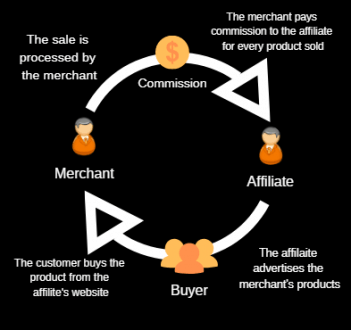Has it ever occurred to you that you’ve earned credit by referring an app to someone? You can earn money without owning a product or providing a service. The affiliate business model works in the same way.
A company that owns no product and has no service to offer but still earns revenue? This is where the Affiliate business model comes into the picture. In the affiliate business model, a firm sells the products of other companies on its website. The buyers buy the products from the firm’s website; however, the sale is transacted to the merchant company’s website, which then releases the commission to the affiliate firm after the order is confirmed.
This is how several companies earn without actually offering any product or service. If you’re muddled between different business models, read our guide to have a clear idea of the different categories of business models with explanations through examples under each category.
Let’s have a look at what exactly the affiliate business model.
What is the Affiliate Business Model?
With the advent of the internet, the affiliate business model has reached a new height. The internet allows marketers to advertise the products of other firms without buying any of them. The affiliate business model has three factors: the merchant firm, the affiliate firm, and the buyer.

The Affiliate firm: The Company that sells any other company’s products on its website without having any access or ownership is called an affiliate firm. This website works like an advertising agency.
The Merchant firm: The Company that advertises its products on the affiliate firm’s website is the merchant firm. An individual can also sell his products on the affiliate’s website to increase sales. The merchant has to pay some amount to the affiliate firm as a commission for the sale.
The buyer: The buyer is the customer who buys the products of the merchant from the affiliate’s website, with or without knowing about the actual seller of the product. The buyer does not pay any part of the commission to the affiliate website.
Affiliate Marketing Programs
The affiliate programs, also called associate programs, are arrangements in which a merchant website gives commission to the affiliate website for sending them more traffic or for referring their business. These affiliate programs are beneficial for both and an effective marketing strategy for online sellers.
Affiliate Program Network
Affiliate networks are the mediators between the individual affiliates and the merchant website. The firm providing the affiliate network tracks all the activity and helps affiliates set up the necessary links to their website.
Most of the affiliate networks have a help center and a directory website that helps the affiliates and the merchant websites track their traffic. The more merchant websites you have on your affiliate network, the more affiliates you attract. As the affiliate network offers a large number of affiliate programs being run by the merchant website, the affiliate network is a real convenience to the affiliate.
How the Affiliate Business Model Works?
After throwing some light upon what the affiliate business model is, let us see “how the affiliate business model works?”
The affiliate business model is a popular marketing strategy used by the merchant firm to increase sales by selling its products on other websites that are called affiliates. The affiliate firm earns money through earning commissions.
The sale is generated when a customer buys any product from the affiliate’s website. Each sale generates results in a commission for the affiliate company. This leads to increased sales for the merchant and brings in cash for the affiliate company. The affiliates are sure to attract the merchants as this also leads to less expense on customer acquisition and allows them more streams to reach their target audience.
This way, the affiliate business model works in a circular motion where the affiliate website displays the products of the merchant. When the customer buys the products from the affiliate’s website, the sale is processed from the merchant’s website, and the commission is paid to the affiliate.
Facts About the Affiliate Revenue Model
The concept of revenue sharing, i.e., paying commissions for referred customers, is an age-old concept before even the affiliate model or the Internet were born. To make you gulp this fact, let us take an example of a brick-and-mortar store. When you enter a store, have you ever noticed the salesmen start hovering over you so they can help you purchase something? After your successful purchase, they get “commission”. This is how an affiliate program works in the real world.
However, this concept was put into practice and patented by William J Tobin, the founder of PC Flowers & Gifts on the Internet. There are different ways in which commissions are offered.
- Based on clicks called pay-per-click (PPC)
- Directly based on an action like a sale, called pay per sale or pay per lead (PPL or CPA – Cost Per Acquisition).
- Based on impressions called pay-per-(a thousand) impressions (PPM or CPM)
This is when an affiliate is paid when someone lands on the merchant’s website.
The affiliate revenue model is famous because it is beneficial for both parties. The merchant website extends its reach, generates more leads, and acquires more customers. The affiliate website earns commissions for each activity occurring on the website. Hence, the affiliate revenue model is a win-win situation for both the merchant as well as the affiliate.
For the successful execution of the affiliate revenue model, you need nothing more than access to the internet and a website. However, if you think the affiliate revenue model and the advertising revenue model are the same, you are highly mistaken. You can take a look at “Top 7 Startup Business Models and Revenue Models for Internet Startups” to have a clear idea of different revenue models.
Examples of Affiliate Programs
The affiliate programs are run on the affiliate networks by the merchant websites. These programs help merchants reach their audience all over the web. It works like a storefront on all the affiliates’ websites that participate in the merchant’s affiliate program. To visualize this process in a better way, let’s have a look at a few examples of companies running successful affiliate programs.

Amazon Affiliate Program
Amazon pioneered the Affiliate business model in 1996 by recruiting thousands of other small websites to generate more traffic on the principal website. Amazon found willing partners among other small businesses, content-based websites, and web portals.
Amazon is one of the largest e-commerce websites today. The Amazon business model is a mixture of several categories of business models. It also follows the Affiliate business model.
Today, the Amazon affiliate program is called Amazon Associates. It is free to enter an Amazon affiliate program. Any website owner or blogger can take part in the Amazon affiliate program by advertising products of Amazon on their sites by creating links, and when the visitor purchases any products through the referred links, the affiliates get a referral bonus. Amazon gives up to 10% commission to each referral purchase.
Ebates Affiliate Program
Ebates is a well-known cashback and shopping reward company that earns revenue through its affiliate network. Ebates gives a reward of $10 just for signing up on the network. The company claims that the Ebates business model helped the company grow to more than 8 million members.
Ebates affiliate program offers $25 cash bonus for every referral purchase and several other bonuses like invitations to private events for influencers and access to insider news and other gimmicks.
Expedia Affiliate Program
Expedia affiliate program is probably one of the biggest names in the travel affiliate world out there! The Expedia affiliate network helps travelers find the best packages. The company offers a 5% commission from the Expedia Collect Inventory and generates revenue from a further 50% commission on every hotel reservation and completion of stay.
Expedia offers a 7-day action referral period, i.e., it gives this time period for visitors referred by the affiliates to convert into customers within 7 days of clicking. The affiliates get paid after this. There are a variety of categories that the affiliates can promote, like hotels, cars, flights, etc. Hence, the Expedia affiliate program attracts more and more affiliates with its vast network and exciting offers.
Are you keen to execute an affiliate business model in your startup?
After knowing the affiliate business model from head to toe, are you curious to start a business similar to the Ebates affiliate network? We at NCrypted provide technical solutions for every problem an entrepreneur might face for starting a startup. We have an affiliate network script that enables you to start your affiliate network website similar to the Ebates affiliate program or the Expedia affiliate program. Contact us to know more about this!
Share your thoughts with us!
What do you think about our blog on the Affiliate business model? Let us know more about your perception of our blog in the comment section below.


i had a big misperception about the affiliate revenue model and the advertising revenue! Thank you for this article. you have explained each and every point in detail!
Hi Himani,
I enjoyed reading your post, I am starting an affiliate business and am interested in how NCRYPTED can help such as website builder, autoresponders, etc; can I do all this through your platform, are there training videos for the process, and what are the costs involved.
Many thanks
Paul Blacker
I have a plan to buy affiliate clone script. But the support system of Ncrypted.com should be improved. As a customer at first before buying I tried to contact support but Its around one week. They are saying they will contact within 48 hours, till now contacting. I request proper authorities to have a look on the issue. Thank you